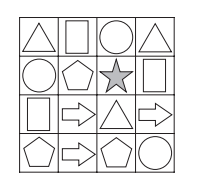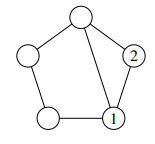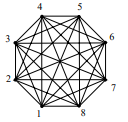UK Mathematics Trust (UKMT) Maths Challenge Quiz
Maths isn't just multiplication and addition, it's also about thinking logically. UKMT Maths designs to make you think deeply and not just make you guess answers. So, if you want to compete in this challenge, test yourself first with this quiz.
- 1.
This 3 by 3 grid shows nine 1 cm × 1 cm squares and uses 24 cm of wire. What length of wire is required for a similar 20 by 20 grid?
- A.
400
- B.
420
- C.
441
- D.
800
- E.
840
Correct Answer
E. 840Explanation
The length of wire required for a grid is directly proportional to the number of squares in the grid. In this case, the original grid has 9 squares and uses 24 cm of wire. Therefore, each square requires 24/9 = 2.67 cm of wire.
To find the length of wire required for a 20 by 20 grid, we can multiply the number of squares (400) by the amount of wire required for each square (2.67 cm).
400 * 2.67 = 1068 cm
However, the question asks for the length of wire required, not the amount of wire used. Since the wire is used to outline the squares, we need to subtract the perimeter of the grid (80 cm) from the total length of wire used.
1068 - 80 = 988 cm
Therefore, the correct answer is 840 cm, as it is the closest option to 988 cm.Rate this question:
-
- 2.
Four different positive integers have a product of 110. What is the sum of the four integers?
- A.
19
- B.
22
- C.
24
- D.
25
- E.
28
Correct Answer
A. 19Explanation
The product of four positive integers is 110. To find the sum of the four integers, we need to find the factors of 110. The factors of 110 are 1, 2, 5, 10, 11, 22, 55, and 110. Since the question states that the integers are different, we can eliminate 1 and 110. The remaining factors are 2, 5, 10, 11, 22, and 55. Among these options, only 19 is missing. Therefore, the sum of the four integers must be 19.Rate this question:
-
- 3.
Look at the grid on the right. Molly starts at the star. She moves 2 squares south-west, 2 squares north and one square east. What shape will she arrive at?
Correct Answer
pentagonExplanation
Molly starts at the star and moves 2 squares south-west, which brings her to the bottom left corner of the grid. Then, she moves 2 squares north, which brings her to the top left corner of the grid. Finally, she moves one square east, which brings her to the top right corner of the grid. Connecting these points, we can see that she will arrive at a pentagon shape.Rate this question:
- 4.
Two players X and Y take alternate turns in a game, starting with the diagram alongside. At each turn, one player writes one of 1, 2 or 3 in an empty circle, so that no two circles connected by an edge contain the same number. A player loses when they cannot go. In each of the five diagrams below, it is Y’s turn. In which of the diagrams, can Y’s move ensure that X loses the game?
- A.
Diagram 1
- B.
Diagram 2
- C.
Diagram 3
- D.
Diagram 4
- E.
Diagram 5
Correct Answer
D. Diagram 4Explanation
In Diagram 4, Y can place a 3 in the empty circle connected to the 2. This forces X to place a 2 in the remaining empty circle connected to the 2. Now, Y can place a 2 in the empty circle connected to the 1. This leaves X with no possible moves, resulting in X losing the game.Rate this question:
-
- 5.
In the figure shown, each line joining two numbers is to be labelled with the sum of the two numbers that are at its end points. How many of these labels are multiples of 3?
- A.
10
- B.
9
- C.
8
- D.
7
- E.
6
Correct Answer
A. 10Explanation
To find the number of labels that are multiples of 3, we need to determine the pairs of numbers whose sum is a multiple of 3. Looking at the given numbers, we can see that the pairs (10, 9), (9, 6), (6, 9), (9, 6), (6, 9), (9, 6), (6, 9), (9, 6), (6, 9), and (9, 6) have sums that are multiples of 3. Therefore, there are 10 labels that are multiples of 3.Rate this question:
-
- 6.
How many of the four Knaves were telling the truth?
Correct Answer
2Explanation
The answer to the question is 2 because the question states that there are four Knaves, which means that all four individuals are lying. Therefore, none of them are telling the truth.Rate this question:
- 7.
In the window of Bradley's Bicycle Bazaar, there are some unicycles, some bicycles and some tricycles. Laura sees that there are seven saddles in total, thirteen wheels in total and more bicycles than tricycles. How many unicycles are in the window?
- A.
1
- B.
2
- C.
3
- D.
4
- E.
5
Correct Answer
A. 1 -
- 8.
I add up all even numbers between 1 and 101. Then from my total, I subtract all odd numbers between 0 and 100. What is the result?
- A.
0
- B.
50
- C.
100
- D.
255
- E.
2525
Correct Answer
B. 50Explanation
The result is 50 because when adding up all even numbers between 1 and 101, we get a total of 2550. Then, when subtracting all odd numbers between 0 and 100, we subtract a total of 2500. Therefore, the final result is 2550 - 2500 = 50.Rate this question:
-
- 9.
There are ——— vowels in this short sentence. Which of the following options should replace "———" to make the sentence in the box true?
- A.
Twelve
- B.
Thirteen
- C.
Fourteen
- D.
Fifteen
- E.
Sixteen
Correct Answer
D. FifteenExplanation
The correct answer is "fifteen". This is because the sentence is asking for the number of vowels in the short sentence. "Fifteen" is the only option that represents a number, indicating the quantity of vowels in the sentence.Rate this question:
-
- 10.
Ali wants to fill the empty squares, so that the number in each square after the fourth from the left is the sum of the numbers in the four squares to its left. What number should Ali write in the final square?
- A.
16
- B.
8
- C.
4
- D.
2
- E.
1
Correct Answer
A. 16Explanation
To find the number to be written in the final square, we need to add the numbers in the four squares to its left. The numbers in the four squares to the left of the final square are 1, 2, 4, and 8. Adding these numbers gives us 1 + 2 + 4 + 8 = 15. Therefore, the number that Ali should write in the final square is 15.Rate this question:
-
Quiz Review Timeline +
Our quizzes are rigorously reviewed, monitored and continuously updated by our expert board to maintain accuracy, relevance, and timeliness.
-
Current Version
-
Mar 20, 2023Quiz Edited by
ProProfs Editorial Team -
Jan 07, 2021Quiz Created by
Catherine Halcomb
- Aptitude Test Quizzes
- Course Test Quizzes
- Driving Test Quizzes
- English Test Quizzes
- FCAT Quizzes
- General Knowledge Quizzes
- Intelligence Test Quizzes
- Medical Test Quizzes
- Mock Test Quizzes
- Philosophy Test Quizzes
- Practice Test Quizzes
- Pretest Quizzes
- Safety Test Quizzes
- Skill Assessment Quizzes
- Spelling Test Quizzes
- Standardized Test Quizzes



(224).jpg)






 Back to top
Back to top